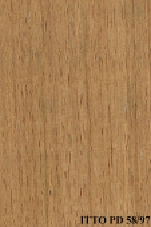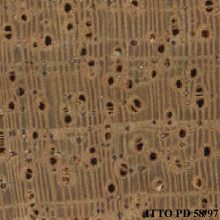
VEN (Pterocarpus erinaceus)
Trade Name
Ven
Scientific Name
Pterocarpus erinaceus Poir.
Family
LEGUMINOSAE
Common Names
Vene (Senegal); Ven (Senegal); Vene (Nigeria); Vene (Mali); Ven (Mali); Goni (Mali); Pau sangue (Guinea-Bissau); Vene (Guinea); Ven (Guinea); Guenin (Burkina Faso); Goni (Burkina Faso); Pau sangue (Equatorial Guinea); Ven
Scientific Name Synonyms
Pterocarpus africanus Hook. in W. Gray
Description Of The Tree
Botanical Description
The tree reaches a height of 23 m. Older trees are reported to be buttressed. The trunk diameter attains 100 cm.
Natural Habitat
Pterocarpus erinaceus is common and widely distributed in the savanna forests and open country. Occasionally found on shallow soil.
Wood Identification
Anatomic Description Of Wood
Wood diffuse porous. Occasionally vessels exclusively solitary (over 90%). Tangential diameter of vessel lumina 200 micras or more (large). Vestured pits. Vessels per mm2 6 to 10 (medium). Simple perforation plates. Vessel-ray pits similar to intervessel pits i Axial parenchyma in marginal or in seemingly marginal bands. Paratracheal axial parenchyma scanty and/or vasicentric. Axial parenchyma aliform. Axial parenchyma confluent. Axial parenchyma storied. Prismatic crystals in short chains in chambered axial parenchy Rays storied. Rays exclusively uniseriate. Homogeneous rays and/or sub-homogeneous rays (all ray cells procumbent). Non-septate fibers. Fibers with simple to minutely bordered pits.
-
 Wood Macro Photo Tangential Plane
Wood Macro Photo Tangential Plane
-
 Wood Micro Photo Of Transversal Section
Wood Micro Photo Of Transversal Section
Availability
Cites Status
Unrestricted
General Wood Description
Color
The sapwood is yellow or pale cream, it has a thickness of 5 cm. The heartwood is red-brown or rose-red, it is clearly demarcated.
Grain
Straight or slightly interlocked, sometimes with an influence on further processing operations.
Texture
The wood is mostly coarse in texture.
Luster
The surface of the wood is naturally low in luster.
Natural Durability
Very durable to decay; without preservative treatment. This species is especially suited for all the uses with risks of permanent or long-lasting humidification. Resistant to termites attack. Heartwood is resistant to Lyctus attacks.
Natural durability index (1= Very high durability, 7=Vey low durability)
1
Internal Growth Stresses
No residual growth stresses are found.
Silica Content
Silica Content: This timber is reported to have a negligible silica content. Silica contents over 0.05% may affect wood processing. Silica Value: 0.01
Resistance To Impregnation
Moderately easy to treat with a partial penetration of the preservative products.
Wood Physical Properties
Basic Density or Specific Gravity (O.D. weight/vol. green) (g/cm³)
0.78
Air-dry Density (Weight and volume at 12%MC) (g/cm³)
0.89
Total shrinkage Tangential (Saturated to 0%MC) (%)
5.9
Total shrinkage Radial (Saturated to 0%MC) (%)
3.2
Drying Defects
Ease of Drying: Drying is moderately easy; some particular care is needed. Drying Defects: Risks of checks. Kiln Schedules: The kiln schedule has been tested.
Recommended Dry Kiln Schedule
FR-7
Dimensional stability ratio (Total Tangential Shrinkage %/Total Radial Shrinkage %)
1.9
Wood Chemical Properties
Wood Mechanical Properties
Bending Strength (MOR),12%MC (kgf/cm²)
1329
Stiffness (MOE) 12%MC (kgf/cm²)
158723
Compression parallel to fiber 12%MC (kgf/cm²)
774
Compression perpendicular to fiber 12%MC (kgf/cm²)
111
Shear strength radial 12%MC (kgf/cm²)
89
Janka hardness (side) 12%MC (kgf)
989
Janka hardness (end grain) 12%MC (kgf)
1037
Workability
Sawing
Sawing of this species requires powerful equipment.
Rotary Veneer Cutting
Suitable for slicing.
Sliced Veneer
Suitable for slicing.
Blunting Effect
Moderate blunting effect; stellited blades for sawing and carbide tools for machining are advised.
Machining
It needs powerful tools for processing. Possible difficulties caused by interlocked grain are reported.
Planing
Moderately easy; tools must be cautiously sharpened.
Moulding
Easy; no particular problems.
Turning
30
Boring
Easy; no particular problems.
Mortising
Easy; no particular problems.
Nailing
Pre-boring is necessary.
Gluing
Difficult to glue because of the extracts content.
Sanding
Easy to perform; it gives good results.
Polishing
Needs pre-coating.
Response To Hand Tools
Working with hand tools is difficult.
REFERENCED USES
End Uses Summary
EXTERIOR GENERAL, paling, HOUSING GENERAL, joists, boards, flooring, parquet, frames, steps, panelling, fittings, FURNITURE AND CABINETS, cabinets, TURNING, ornaments, OTHER AND MUSICAL INSTRUMENTS, handicrafts
Exterior General
- 1 - Tabela de resultados de ensaios fisicos e mecanicos
Paling Fence Pickets
- 4 - Estudo dendrologico e determinacao das caracteristicas fisicas e mecanicas da bicuiba
General Housing
- 10 - Silica in Timbers
Joists
- 12 - Tropical timbers of the world. Part I-Tropical American Species
Boards
- 13 - Dry kiln schedules for commercial woods. Temperate and tropical. Section III. Latin American (Mexico, Central, and South America) Woods–Conventional Temperatures
Flooring
- 14 - Handbook of Hardwoods
Parquet
- 15 - Empire Timbers
Frames
- 16 - Woods of the World
Steps
- 17 - Tree Conservation Database
Paneling
- 18 - W3TROPICOS Missouri Botanical Garden
Fittings
- 19 - Silica in Timbers
Furniture Cabinets
- 21 - Tropical timbers of the world. Part III-Southeast Asian and Oceanian Species.
Cabinet
- 24 - Empire Timbers
Turning
- 30 - Embassy of Honduras in Japan
Ornaments
- 31 - Embassy of Colombia in Japan
Handcraft
- 66 - Maderas latinoamericanas. VII. Caracteristicas anatomicas. propiedades fisicomecanicas, de secado, y tratabilidad de la madera juvenil de Cordia alliodora (Ruiz & Pav. Oken.)
Please Provide Information To View Producer Information